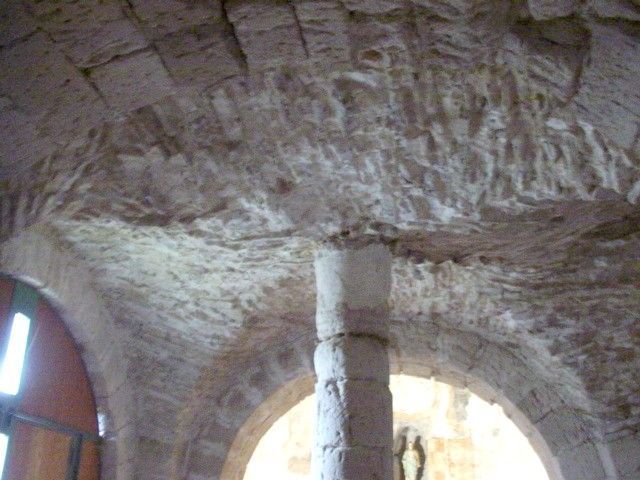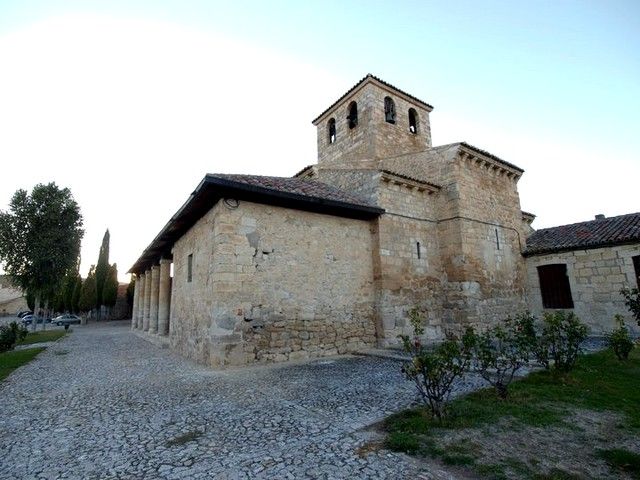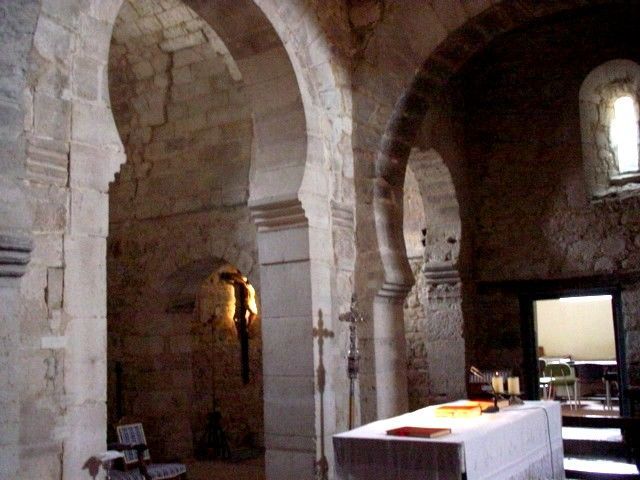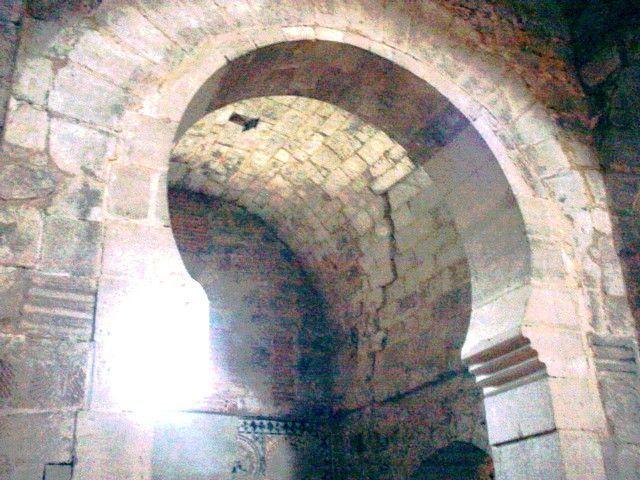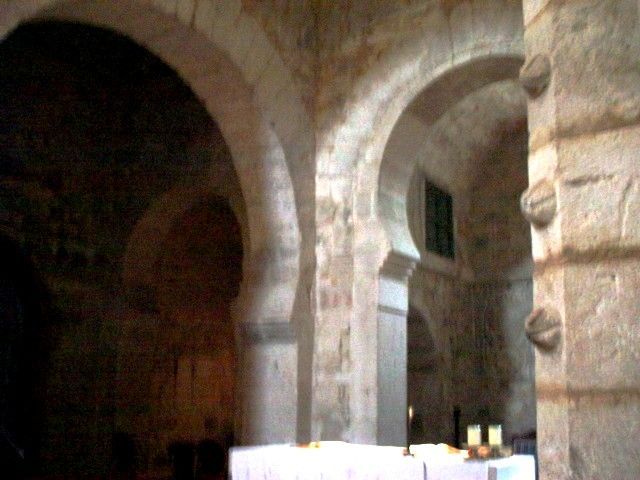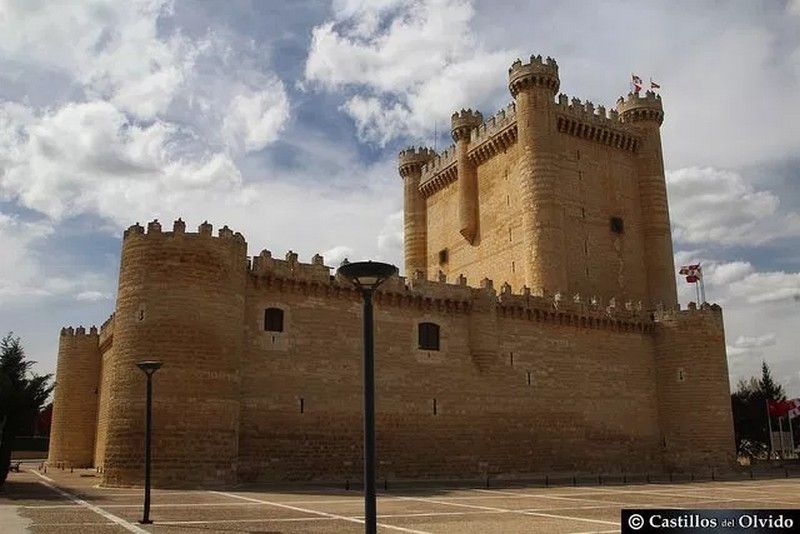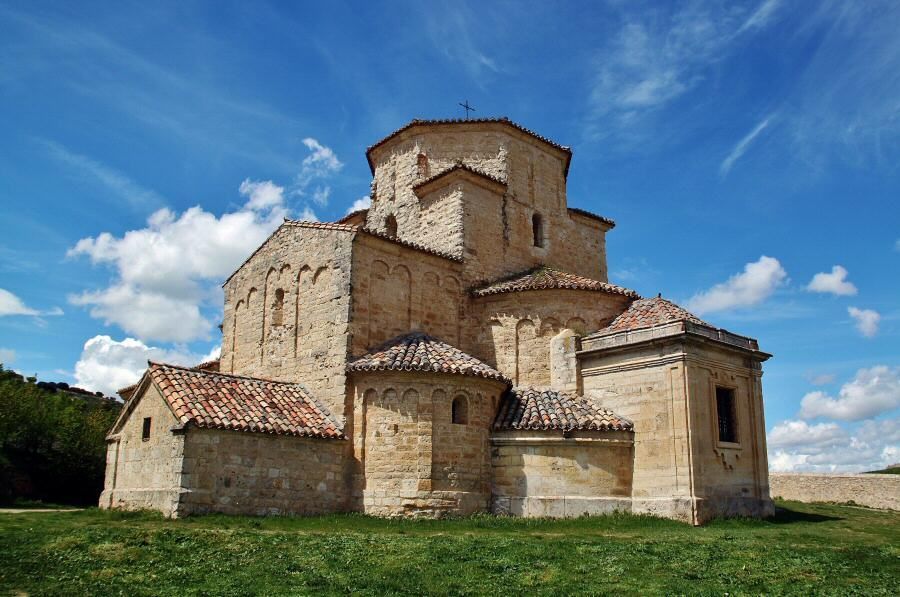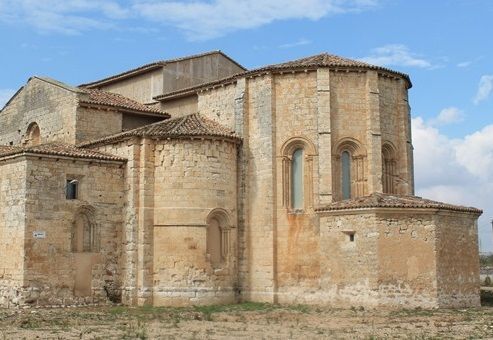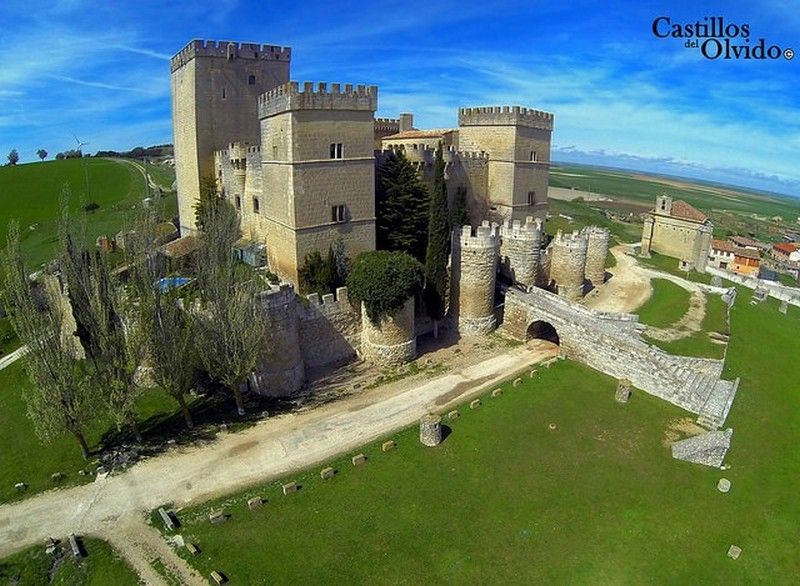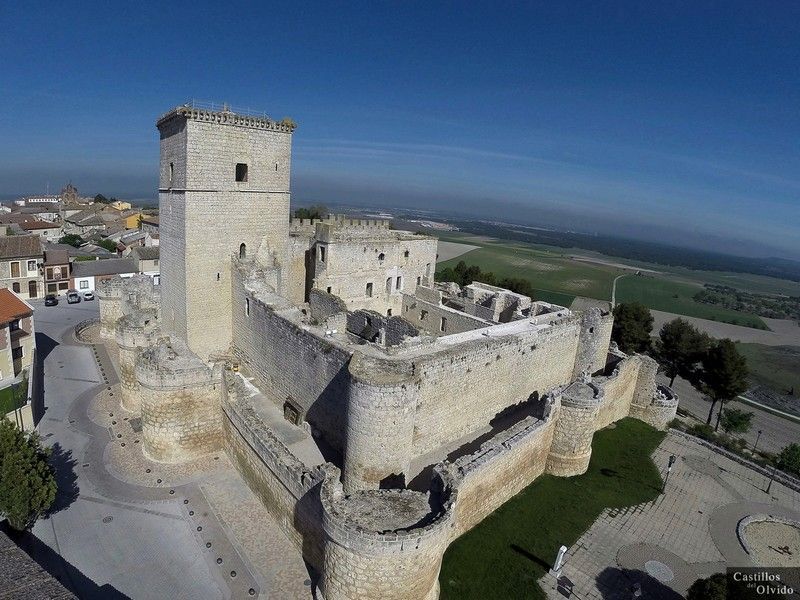SANTA MARÍA DE WAMBA
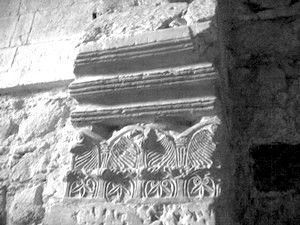
Previous notes
- Declared National Monument in 1931.
- Mozarabic church from which only the three-part flat chevet and part of the naves have been preserved; built upon a Visigothic church where it is believed that King Wamba was elected as successor to Recesvinto.
Historic environment
There are several reasons to think that today’s Wamba was the royal village of Gérticos in Visigothic times. It is believed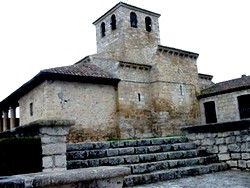 that Recesvinto was born and also died here in 672, where Wamba was elected as his successor, as we know that Gérticos was located in this area and it is certain the existence of a Visigothic church in this place of which rests of decoration are preserved in the Archeological Museum of Valladolid. Later, in 928, there is a reference to Frunimius, probably the Head of the seat of León in those years, as Bishop of Wamba. Besides, the Monastery of Wamba is mentioned in a document of 948. All of this suggests the possibility that during the repopulation of all of this area after Alphonse the Third conquered the territories located at the north of the Duero river and, given the interest shown by the Asturian monarchy to be considered as a continuation the the Visigothic one, the repopulation of such an important place for the Visigothic kingdom was utmost important and it is not at all strange that this process was associated to a king’s name who, besides having been elected in this place, was one that has left the best memories among the kings of those times. That implied the immediate reconstruction of the existing church since the times of Recesvinto and that, as we note the differences between this church and the one very near by of San Cebrián de Mazote, must have been the first one that was reconstructed in this area and possibly Wamba was repopulated by people who came from the north, -which is not the case of the former one- since, as we shall see, it is a building much nearer to the Visigothic and Asturian influences than those that could have contributed the Christians that came from Al Andalus.
that Recesvinto was born and also died here in 672, where Wamba was elected as his successor, as we know that Gérticos was located in this area and it is certain the existence of a Visigothic church in this place of which rests of decoration are preserved in the Archeological Museum of Valladolid. Later, in 928, there is a reference to Frunimius, probably the Head of the seat of León in those years, as Bishop of Wamba. Besides, the Monastery of Wamba is mentioned in a document of 948. All of this suggests the possibility that during the repopulation of all of this area after Alphonse the Third conquered the territories located at the north of the Duero river and, given the interest shown by the Asturian monarchy to be considered as a continuation the the Visigothic one, the repopulation of such an important place for the Visigothic kingdom was utmost important and it is not at all strange that this process was associated to a king’s name who, besides having been elected in this place, was one that has left the best memories among the kings of those times. That implied the immediate reconstruction of the existing church since the times of Recesvinto and that, as we note the differences between this church and the one very near by of San Cebrián de Mazote, must have been the first one that was reconstructed in this area and possibly Wamba was repopulated by people who came from the north, -which is not the case of the former one- since, as we shall see, it is a building much nearer to the Visigothic and Asturian influences than those that could have contributed the Christians that came from Al Andalus.
 that Recesvinto was born and also died here in 672, where Wamba was elected as his successor, as we know that Gérticos was located in this area and it is certain the existence of a Visigothic church in this place of which rests of decoration are preserved in the Archeological Museum of Valladolid. Later, in 928, there is a reference to Frunimius, probably the Head of the seat of León in those years, as Bishop of Wamba. Besides, the Monastery of Wamba is mentioned in a document of 948. All of this suggests the possibility that during the repopulation of all of this area after Alphonse the Third conquered the territories located at the north of the Duero river and, given the interest shown by the Asturian monarchy to be considered as a continuation the the Visigothic one, the repopulation of such an important place for the Visigothic kingdom was utmost important and it is not at all strange that this process was associated to a king’s name who, besides having been elected in this place, was one that has left the best memories among the kings of those times. That implied the immediate reconstruction of the existing church since the times of Recesvinto and that, as we note the differences between this church and the one very near by of San Cebrián de Mazote, must have been the first one that was reconstructed in this area and possibly Wamba was repopulated by people who came from the north, -which is not the case of the former one- since, as we shall see, it is a building much nearer to the Visigothic and Asturian influences than those that could have contributed the Christians that came from Al Andalus.
that Recesvinto was born and also died here in 672, where Wamba was elected as his successor, as we know that Gérticos was located in this area and it is certain the existence of a Visigothic church in this place of which rests of decoration are preserved in the Archeological Museum of Valladolid. Later, in 928, there is a reference to Frunimius, probably the Head of the seat of León in those years, as Bishop of Wamba. Besides, the Monastery of Wamba is mentioned in a document of 948. All of this suggests the possibility that during the repopulation of all of this area after Alphonse the Third conquered the territories located at the north of the Duero river and, given the interest shown by the Asturian monarchy to be considered as a continuation the the Visigothic one, the repopulation of such an important place for the Visigothic kingdom was utmost important and it is not at all strange that this process was associated to a king’s name who, besides having been elected in this place, was one that has left the best memories among the kings of those times. That implied the immediate reconstruction of the existing church since the times of Recesvinto and that, as we note the differences between this church and the one very near by of San Cebrián de Mazote, must have been the first one that was reconstructed in this area and possibly Wamba was repopulated by people who came from the north, -which is not the case of the former one- since, as we shall see, it is a building much nearer to the Visigothic and Asturian influences than those that could have contributed the Christians that came from Al Andalus.Description
From the Mozarabic church only the triple sanctuary, the first stretch of the naves and the complete northern wall have been preserved, although we know the structure of its original plan, whereas the rest was replaced and enlarged at the end of the 12th century, when Santa María de Wamba became to depend from the Knights Hospitallers of the Order of St. John. Its shape it is similar to Santa María de Lebeña but much more elongated and formed by a rectangle 18 m long by 12 m wide divided in nine zones by horseshoe archs upon pillars against a three rectangular apses sanctuary, the central one protruding in the headwall. This apse is larger than the lateral ones and -as in Mazote and different to Lebeña- have their external walls parallel and the chevet is as wide as the rest of the church. However, the interior shape of the three apses is rectangular as in the Cantabrian church. Its plan is clearly related with the set of cruciform Visigothic churches that started the importation of the model of the Mausoleum of Gala Placidia in Rávena for the building of San Fructuoso de Montelios that, according to our point of view, as we have mentioned in several occasions, was followed in churches like Santa Comba de Bande, San Pedro de la Mata, Santa María de Melque or San Miguel de Tarrasa and that would continue in Carolingian buildings like Germiny-des-Prés. In Wamba its is also very meaningful the influence of Asturian art in
plan, whereas the rest was replaced and enlarged at the end of the 12th century, when Santa María de Wamba became to depend from the Knights Hospitallers of the Order of St. John. Its shape it is similar to Santa María de Lebeña but much more elongated and formed by a rectangle 18 m long by 12 m wide divided in nine zones by horseshoe archs upon pillars against a three rectangular apses sanctuary, the central one protruding in the headwall. This apse is larger than the lateral ones and -as in Mazote and different to Lebeña- have their external walls parallel and the chevet is as wide as the rest of the church. However, the interior shape of the three apses is rectangular as in the Cantabrian church. Its plan is clearly related with the set of cruciform Visigothic churches that started the importation of the model of the Mausoleum of Gala Placidia in Rávena for the building of San Fructuoso de Montelios that, according to our point of view, as we have mentioned in several occasions, was followed in churches like Santa Comba de Bande, San Pedro de la Mata, Santa María de Melque or San Miguel de Tarrasa and that would continue in Carolingian buildings like Germiny-des-Prés. In Wamba its is also very meaningful the influence of Asturian art in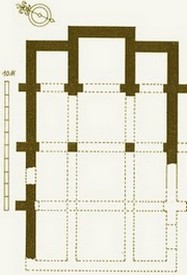 the buttresses of the lateral walls and in the shape of its tripartite chevet, flat and with its protruding central apse, although in thuis case we cannot know if, as in Lebeña, the three compartments that existed in the opposite side, also formed an Asturian type portico. Now, externally, we can only see the three walls of the headwall where we can clearly distinguish several construction styles at different heights. The rest of what that still persists is surrounded by later constructions.
the buttresses of the lateral walls and in the shape of its tripartite chevet, flat and with its protruding central apse, although in thuis case we cannot know if, as in Lebeña, the three compartments that existed in the opposite side, also formed an Asturian type portico. Now, externally, we can only see the three walls of the headwall where we can clearly distinguish several construction styles at different heights. The rest of what that still persists is surrounded by later constructions.
 plan, whereas the rest was replaced and enlarged at the end of the 12th century, when Santa María de Wamba became to depend from the Knights Hospitallers of the Order of St. John. Its shape it is similar to Santa María de Lebeña but much more elongated and formed by a rectangle 18 m long by 12 m wide divided in nine zones by horseshoe archs upon pillars against a three rectangular apses sanctuary, the central one protruding in the headwall. This apse is larger than the lateral ones and -as in Mazote and different to Lebeña- have their external walls parallel and the chevet is as wide as the rest of the church. However, the interior shape of the three apses is rectangular as in the Cantabrian church. Its plan is clearly related with the set of cruciform Visigothic churches that started the importation of the model of the Mausoleum of Gala Placidia in Rávena for the building of San Fructuoso de Montelios that, according to our point of view, as we have mentioned in several occasions, was followed in churches like Santa Comba de Bande, San Pedro de la Mata, Santa María de Melque or San Miguel de Tarrasa and that would continue in Carolingian buildings like Germiny-des-Prés. In Wamba its is also very meaningful the influence of Asturian art in
plan, whereas the rest was replaced and enlarged at the end of the 12th century, when Santa María de Wamba became to depend from the Knights Hospitallers of the Order of St. John. Its shape it is similar to Santa María de Lebeña but much more elongated and formed by a rectangle 18 m long by 12 m wide divided in nine zones by horseshoe archs upon pillars against a three rectangular apses sanctuary, the central one protruding in the headwall. This apse is larger than the lateral ones and -as in Mazote and different to Lebeña- have their external walls parallel and the chevet is as wide as the rest of the church. However, the interior shape of the three apses is rectangular as in the Cantabrian church. Its plan is clearly related with the set of cruciform Visigothic churches that started the importation of the model of the Mausoleum of Gala Placidia in Rávena for the building of San Fructuoso de Montelios that, according to our point of view, as we have mentioned in several occasions, was followed in churches like Santa Comba de Bande, San Pedro de la Mata, Santa María de Melque or San Miguel de Tarrasa and that would continue in Carolingian buildings like Germiny-des-Prés. In Wamba its is also very meaningful the influence of Asturian art in the buttresses of the lateral walls and in the shape of its tripartite chevet, flat and with its protruding central apse, although in thuis case we cannot know if, as in Lebeña, the three compartments that existed in the opposite side, also formed an Asturian type portico. Now, externally, we can only see the three walls of the headwall where we can clearly distinguish several construction styles at different heights. The rest of what that still persists is surrounded by later constructions.
the buttresses of the lateral walls and in the shape of its tripartite chevet, flat and with its protruding central apse, although in thuis case we cannot know if, as in Lebeña, the three compartments that existed in the opposite side, also formed an Asturian type portico. Now, externally, we can only see the three walls of the headwall where we can clearly distinguish several construction styles at different heights. The rest of what that still persists is surrounded by later constructions.
The distribution of the inner space must have been very similar to that of Santa María de Lebeña; however, the impression it produces is a very different one, since in Wamba there are no columns nor capitals, and the arches rest almost directly upon pillars by means of keel mouldings that elongate towards the arches’ interior enlarging the horseshoe effect, that in this way they end up prolongued up to two thirds of the radius. Besides, this church has the peculiarity that the ratio between the total height of the hollow parts and its arch’s diameter is just 2:1; very small if compared with the usual in Mozarabic art in this area and more typical from Navarra and the Hispanic March and above all, from the Visigiothic art, still preserved in the laterals of the central arch that gives access to the crossing the fixing hollows of the curtain’s support that separates the faithful from the clergy, mandatory in the cult of Visigothic Spain that is now defined as Mozarabic lithurgy. To this we have to add the sensation of solidity produced all over the area that has been preserved of the Mozarabic construction due both, to its voussoir arches, very large and very well chiseled, with the extrados embedded in the wall, as well as to its keel mouldings, also very large and with a very scarce decoration, as well as for the fact that instead of the new techniques brought by the Arabs, only horse shoed barrel vaults have been used for the cover of every space preserved, which are typical of the Visigothic art, although in this case, very little elongated and placed longitudinally much higher than the arches that frame it and built upon small ashlars very well engraved. The final result is that of an aesthetics much more enclosed than what is usual in Mozarabic Astur-Leonés art, that recalls several Visigothic buildings. This
very small if compared with the usual in Mozarabic art in this area and more typical from Navarra and the Hispanic March and above all, from the Visigiothic art, still preserved in the laterals of the central arch that gives access to the crossing the fixing hollows of the curtain’s support that separates the faithful from the clergy, mandatory in the cult of Visigothic Spain that is now defined as Mozarabic lithurgy. To this we have to add the sensation of solidity produced all over the area that has been preserved of the Mozarabic construction due both, to its voussoir arches, very large and very well chiseled, with the extrados embedded in the wall, as well as to its keel mouldings, also very large and with a very scarce decoration, as well as for the fact that instead of the new techniques brought by the Arabs, only horse shoed barrel vaults have been used for the cover of every space preserved, which are typical of the Visigothic art, although in this case, very little elongated and placed longitudinally much higher than the arches that frame it and built upon small ashlars very well engraved. The final result is that of an aesthetics much more enclosed than what is usual in Mozarabic Astur-Leonés art, that recalls several Visigothic buildings. This  leads us to consider the possibility that this church is the most ancient one among those called Mozarabic in the Astur-Leonés kingdom and even that it was rebuilt upon a Visigothic church, reutilizing an important part of its structure and adding an Asturian type chevet in the plans design but with important influences of Visigotghic art in its elevation.
leads us to consider the possibility that this church is the most ancient one among those called Mozarabic in the Astur-Leonés kingdom and even that it was rebuilt upon a Visigothic church, reutilizing an important part of its structure and adding an Asturian type chevet in the plans design but with important influences of Visigotghic art in its elevation.
 very small if compared with the usual in Mozarabic art in this area and more typical from Navarra and the Hispanic March and above all, from the Visigiothic art, still preserved in the laterals of the central arch that gives access to the crossing the fixing hollows of the curtain’s support that separates the faithful from the clergy, mandatory in the cult of Visigothic Spain that is now defined as Mozarabic lithurgy. To this we have to add the sensation of solidity produced all over the area that has been preserved of the Mozarabic construction due both, to its voussoir arches, very large and very well chiseled, with the extrados embedded in the wall, as well as to its keel mouldings, also very large and with a very scarce decoration, as well as for the fact that instead of the new techniques brought by the Arabs, only horse shoed barrel vaults have been used for the cover of every space preserved, which are typical of the Visigothic art, although in this case, very little elongated and placed longitudinally much higher than the arches that frame it and built upon small ashlars very well engraved. The final result is that of an aesthetics much more enclosed than what is usual in Mozarabic Astur-Leonés art, that recalls several Visigothic buildings. This
very small if compared with the usual in Mozarabic art in this area and more typical from Navarra and the Hispanic March and above all, from the Visigiothic art, still preserved in the laterals of the central arch that gives access to the crossing the fixing hollows of the curtain’s support that separates the faithful from the clergy, mandatory in the cult of Visigothic Spain that is now defined as Mozarabic lithurgy. To this we have to add the sensation of solidity produced all over the area that has been preserved of the Mozarabic construction due both, to its voussoir arches, very large and very well chiseled, with the extrados embedded in the wall, as well as to its keel mouldings, also very large and with a very scarce decoration, as well as for the fact that instead of the new techniques brought by the Arabs, only horse shoed barrel vaults have been used for the cover of every space preserved, which are typical of the Visigothic art, although in this case, very little elongated and placed longitudinally much higher than the arches that frame it and built upon small ashlars very well engraved. The final result is that of an aesthetics much more enclosed than what is usual in Mozarabic Astur-Leonés art, that recalls several Visigothic buildings. This  leads us to consider the possibility that this church is the most ancient one among those called Mozarabic in the Astur-Leonés kingdom and even that it was rebuilt upon a Visigothic church, reutilizing an important part of its structure and adding an Asturian type chevet in the plans design but with important influences of Visigotghic art in its elevation.
leads us to consider the possibility that this church is the most ancient one among those called Mozarabic in the Astur-Leonés kingdom and even that it was rebuilt upon a Visigothic church, reutilizing an important part of its structure and adding an Asturian type chevet in the plans design but with important influences of Visigotghic art in its elevation.
As far as its sculpted decoration, it is a very limited one as it is only reduced to the friezes of pseudo Corynthian type, that bear a certain resemblance with some elements of San Fructuoso de Montelios, located under the keel mouldings of the southern apse’s entrance arch, the triple molding that decorates the lower part of the keel mouldings of all the arches, that recall the existing one in the upper part of those of Santa María de Melque, and the imposts formed only by a rectangular ledge that mark the beginning of the barrel vaults. The paintings that still exist on the wall of the major chapel seem to be more interesting. They are formed by eight medallions with motifs similar to those of the upper frieze of Quintanilla de las Viñas, surrounding two crosses. In principle, though the motifs of the medallions seem much older, it is considered that the paintings are from the eleventh century or even from the beginnings of the twelfth century, when compared with the medallions with the eagles in San Baudelio de Berlanga, although we think that there are many doubts with regard that all the Berlanga paintings are from later than 1100, and if it were so, there would not be any reason to date the Wamba ones so lately.
Conclusions
As a conclusion, it is obvious that we are in front of a monument of great interest to know the development of the Mozarabic art but, different to the near by church of San Cebrián de Mazote, it requires a complicated analysis because the Visigothic influences are much more meaningful, to the point that, had the chevet been not so clearly of the Asturian type, without any known precedents in Visigothic art -since the triple chevets of San Juan de Baños and Santa Lucía del Trampal are very different- we could think we are in front of a case similar to that of Santa Comba de Bande, and that at the end of the ninth or beginnings of the tenth century, when the area was repopulated. the new settlers limited themselves to rebuild -as close to the original as possible- a Visigothic church that still partly existed, as can be seen in the lower part of the chevet, up to two meters high, and for that purpose they utilized the knowledge and the structures that existed in the Christian territories at those times, like the triple Asturian chevets and the horseshoe barrel vaults, which nearest example they had in San Juan de Baños, 50 Km far. Later this model would have been utilized with some modifications in the building of Santa María de Lebeña.
the Visigothic influences are much more meaningful, to the point that, had the chevet been not so clearly of the Asturian type, without any known precedents in Visigothic art -since the triple chevets of San Juan de Baños and Santa Lucía del Trampal are very different- we could think we are in front of a case similar to that of Santa Comba de Bande, and that at the end of the ninth or beginnings of the tenth century, when the area was repopulated. the new settlers limited themselves to rebuild -as close to the original as possible- a Visigothic church that still partly existed, as can be seen in the lower part of the chevet, up to two meters high, and for that purpose they utilized the knowledge and the structures that existed in the Christian territories at those times, like the triple Asturian chevets and the horseshoe barrel vaults, which nearest example they had in San Juan de Baños, 50 Km far. Later this model would have been utilized with some modifications in the building of Santa María de Lebeña.
 the Visigothic influences are much more meaningful, to the point that, had the chevet been not so clearly of the Asturian type, without any known precedents in Visigothic art -since the triple chevets of San Juan de Baños and Santa Lucía del Trampal are very different- we could think we are in front of a case similar to that of Santa Comba de Bande, and that at the end of the ninth or beginnings of the tenth century, when the area was repopulated. the new settlers limited themselves to rebuild -as close to the original as possible- a Visigothic church that still partly existed, as can be seen in the lower part of the chevet, up to two meters high, and for that purpose they utilized the knowledge and the structures that existed in the Christian territories at those times, like the triple Asturian chevets and the horseshoe barrel vaults, which nearest example they had in San Juan de Baños, 50 Km far. Later this model would have been utilized with some modifications in the building of Santa María de Lebeña.
the Visigothic influences are much more meaningful, to the point that, had the chevet been not so clearly of the Asturian type, without any known precedents in Visigothic art -since the triple chevets of San Juan de Baños and Santa Lucía del Trampal are very different- we could think we are in front of a case similar to that of Santa Comba de Bande, and that at the end of the ninth or beginnings of the tenth century, when the area was repopulated. the new settlers limited themselves to rebuild -as close to the original as possible- a Visigothic church that still partly existed, as can be seen in the lower part of the chevet, up to two meters high, and for that purpose they utilized the knowledge and the structures that existed in the Christian territories at those times, like the triple Asturian chevets and the horseshoe barrel vaults, which nearest example they had in San Juan de Baños, 50 Km far. Later this model would have been utilized with some modifications in the building of Santa María de Lebeña.
In Santa María de Wamba we can also get to know a wide range of subjects of interest in the part of the rebuilt church by de Knights Hospitallers of the Order of St. John, Cistercian, from the twelfth century; a compartment leaning to the northern crossing, of uncertain date, covered by a groin vault with a central column that recalls San Baudelio de Berlanga, although not comparable in size; several paintings and sculptures of different periods and an astonishing ossuary that still contains parts of the thousands of skeletons deposited throughout the 13th and 18th centuries, besides a very interesting Byzantine capital of the end of the 5th century, turned into a stoup that could well have inspired the engravers of the most interestings capitals of Mozarabic art of that area.
Other interesting information
Access: Leave Valladolid from VA-514 to La Mota and continue till Wamba. Total 18 Km.
GPS Coordinates: 41º 40′ 34,42″N 4º 55′ 3,91″W.
Information Telephone: Ayuntamiento de Wamba: 983.56.33.17
Visiting hours: Contact the Town City Hall (Ayuntamiento): Fridays from 17:00 to 19:30. Saturdays, Sundays and Holidays: from 10:00 to 13:30 and from 17:00 to 19:30. Tickets free
Bibliography
Imagen del Arte Mozárabe; José Fernández Arenas
SUMMA ARTIS: Tomo VIII
L’Art Preroman Hispanique – L’Art Mozarabe: Jacques Fontaine(ZODIAQUE)
Arte y Arquitectura en España 500/1250: Joaquín Yarza
Portals
http://www.jdiezarnal.com/santamariadewamba.html
http://canales.nortecastilla.es/pueblos/wamba.htm
http://www.artehistoria.jcyl.es/artesp/monumentos/260.htm
Share on:











